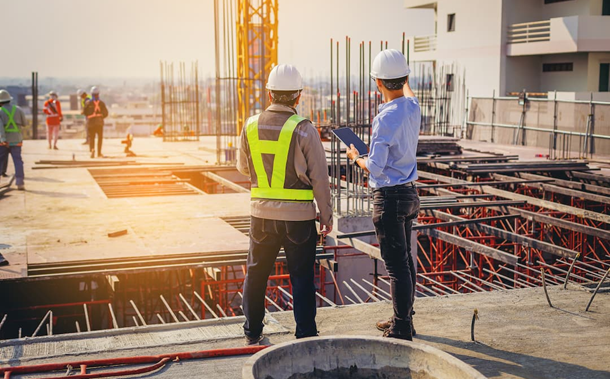Evaluation of Skirt-Raft Foundation Performance Adjacent to Unsupported Excavations
Downloads
Doi:10.28991/CEJ-2024-010-12-018
Full Text:PDF
Downloads
[2] Dong, J., Bai, Q., Zhao, W., & Wang, B. (2023). Test Study on the Influence of Foundation Pit Excavation on the Surface Settlement of Sandy Soil Natural Foundation of Adjacent Buildings. Buildings, 13(5), 1293. doi:10.3390/buildings13051293.
[3] Zhang, D. (2023). Influences of Deep Foundation Pit Excavation on the Stability of Adjacent Ancient Buildings. Buildings, 13(8), 4. doi:10.3390/buildings13082004.
[4] Mangi, N., Kumar, M., Mangnejo, D. A., Karira, H., Jhatial, A. A., & Lakhair, F. R. (2019). Crack Pattern Investigation in the Structural Members of a Framed Two-Floor Building due to Excavation-Induced Ground Movement. Engineering, Technology and Applied Science Research, 9(4), 4463–4468. doi:10.48084/etasr.2923.
[5] Schuster, M., Kung, G. T.-C., Juang, C. H., & Hashash, Y. M. A. (2009). Simplified Model for Evaluating Damage Potential of Buildings Adjacent to a Braced Excavation. Journal of Geotechnical and Geoenvironmental Engineering, 135(12), 1823–1835. doi:10.1061/(asce)gt.1943-5606.0000161.
[6] Piciullo, L., Ritter, S., Lysdahl, A. O. K., Langford, J., & Nadim, F. (2021). Assessment of building damage due to excavation-induced displacements: The GIBV method. Tunnelling and Underground Space Technology, 108. doi:10.1016/j.tust.2020.103673.
[7] Khalid, M. H., & Alshameri, B. (2022). Determination of safe depth and lateral distance of unsupported excavation near mat foundation in cohesive soils using Plaxis. Journal of Applied Science and Engineering, 25(2), 249–260. doi:10.6180/jase.202204_25(2).0011.
[8] Castaldo, P., Calvello, M., & Palazzo, B. (2013). Probabilistic analysis of excavation-induced damages to existing structures. Computers and Geotechnics, 53, 17–30. doi:10.1016/j.compgeo.2013.04.008.
[9] Zhao, J., Ritter, S., & DeJong, M. J. (2022). Early-stage assessment of structural damage caused by braced excavations: Uncertainty quantification and a probabilistic analysis approach. Tunnelling and Underground Space Technology, 125. doi:10.1016/j.tust.2022.104499.
[10] Zhang, X., & Zhan, Z. (2021). Evaluation of Risk of Building Damage due to Deep Excavations via Numerical Modelling. Advances in Civil Engineering, 2021. doi:10.1155/2021/6646094.
[11] Bjerrum, L. (1963). Discussion on compressibility of soils. Proceedings of the European conference on soil mechanics and foundation engineering, 24-27 September, 1963, Budapest, Hungary.
[12] Yang, Y., Li, X., & Chen, Y. (2022). The Influence of Different Excavation Methods on Deep Foundation Pit and Surrounding Environment. Lecture Notes in Civil Engineering, 213 LNCE, 109–129. doi:10.1007/978-981-19-1260-3_11.
[13] Zhang, Q. (2020). Deformation analysis of deep foundation pit excavation in China under time-space effect. Geotechnical Research, 7(3), 146–152. doi:10.1680/jgere.20.00009.
[14] Burland, J. B., & Wroth, C. P. (1975). Settlement of buildings and associated damage. Proceedings of the Conference of the British Geotechnical Society, No. CP 33/75.
[15] Wang, Z. Yu, Gu, D. Ming, & Zhang, W. Gang. (2020). Influence of excavation schemes on slope stability: A DEM study. Journal of Mountain Science, 17(6), 1509–1522. doi:10.1007/s11629-019-5605-6.
[16] Hu, J., & Ma, F. (2018). Failure Investigation at a Collapsed Deep Open Cut Slope Excavation in Soft Clay. Geotechnical and Geological Engineering, 36(1), 665–683. doi:10.1007/s10706-017-0337-2.
[17] Rankin, W. J. (1988). Ground movements resulting from urban tunnelling: Predictions and effects. Geological Society Engineering Geology Special Publication, 5(5), 79–92. doi:10.1144/GSL.ENG.1988.005.01.06.
[18] Shaaban, M. G., Kenawi, M. A., Senoon, A. A. A., & El-Naiem, M. A. A. (2023). Effects of excavation and construction sequence on behavior of existing pile groups. Innovative Infrastructure Solutions, 8(8), 223. doi:10.1007/s41062-023-01193-8.
[19] Al-Jorany, A. N., & Al-Qaisee, G. S. (2016). Field Observation of Soil Displacements Resulting Due Unsupported Excavation and Its Effects on Proposed Adjacent Piles. Journal of Engineering, 22(5), 11–28. doi:10.31026/j.eng.2016.05.02.
[20] Al-Soudani, W. H., & Albusoda, B. S. (2024). Experimental and numerical simulation of a ring and wings-open-ended pipe pile. Innovative Infrastructure Solutions, 9(1), 27. doi:10.1007/s41062-023-01323-2.
[21] Miao, Y., Liu, B., Liu, C., Shu, Z., & Wu, H. (2020). Experimental Study on Stability Analysis of a Structure during Excavation beneath This Structure. Advances in Civil Engineering, 2020(1), 9268927. doi:10.1155/2020/9268927.
[22] Wei, H. (2021). Influence of Foundation Pit Excavation and Precipitation on Settlement of Surrounding Buildings. Advances in Civil Engineering, 6638868. doi:10.1155/2021/6638868.
[23] Wang, K., Yang, Z., Guo, J., Dang, Y., & Yan, Y. (2023). Numerical Analysis of the Influence of Deep Excavation on Nearby Pile Foundation Building. Buildings, 13(11), 2842. doi:10.3390/buildings13112842.
[24] Soomro, M. A., Memon, K. F., Soomro, M. A., Memon, A., & Keerio, M. A. (2018). Single Pile Settlement and Load Transfer Mechanism due to Excavation in Silty Clay. Engineering, Technology & Applied Science Research, 8(1), 2485–2492. doi:10.48084/etasr.1666.
[25] Soomro, M. A., Brohi, A. S., Soomro, M. A., Bangwar, D. K., & Bhatti, S. A. (2018). 3D Numerical Modeling of Pile Group Responses to Excavation-Induced Stress Release in Silty Clay. Engineering, Technology & Applied Science Research, 8(1), 2577–2584. doi:10.48084/etasr.1748.
[26] Mangnejo, D. A., Soomro, M. A., Mangi, N., Halepoto, I. A., & Dahri, I. A. (2018). A Parametric Study of Effect on Single Pile Integrity Due to an Adjacent Excavation Induced Stress Release in Soft Clay. Engineering, Technology & Applied Science Research, 8(4), 3189–3193. doi:10.48084/etasr.2105.
[27] Yu, Z. T., Wang, H. Y., Wang, W., Ling, D. S., Zhang, X. D., Wang, C., & Qu, Y. H. (2021). Experimental and Numerical Investigation on the Effects of Foundation Pit Excavation on Adjacent Tunnels in Soft Soil. Mathematical Problems in Engineering, 5587857. doi:10.1155/2021/5587857.
[28] Liu, F., Zhang, X., Xiang, M., Lyu, J., Feng, R., & LIU, S. (2024). Experimental study on stress and deformation characteristics of foundation pit considering excavation width using 3D printing technology. Frontiers in Earth Science, 12. doi:10.3389/feart.2024.1373140.
[29] Xie, L., & Liu, S. (2022). Analysis of the influence of super large area and super deep foundation pit excavation construction on surrounding subways. Journal of Mechatronics and Artificial Intelligence in Engineering, 3(2), 65–75. doi:10.21595/jmai.2022.22776.
[30] Uba Uge, B., & Guo, Y. (2020). Deep Foundation Pit Excavations Adjacent to Disconnected Piled Rafts: A Review on Risk Control Practice. Open Journal of Civil Engineering, 10(03), 270–300. doi:10.4236/ojce.2020.103023.
[31] Al-Qaisee, G. S., Ahmed, M. D., & Ahmed, B. A. (2020). Performance of piled raft foundations under the effect of dewatering nearby an open pit. IOP Conference Series: Materials Science and Engineering, 737(1), 12081. doi:10.1088/1757-899X/737/1/012081.
[32] Liang, Y. Y., Liu, N. W., Yu, F., Gong, X. N., & Chen, Y. T. (2019). Prediction of response of existing building piles to adjacent deep excavation in soft clay. Advances in Civil Engineering, 8914708. doi:10.1155/2019/8914708.
[33] Niu, Y., Wang, Q., & Ma, F. (2023). Study on the Influence of Foundation Pit Excavation on the Deformation of Adjacent Subway Tunnel in the Affected Area of Fault Zones. Sustainability (Switzerland), 15(12), 9462. doi:10.3390/su15129462.
[34] Amarasinghe, M. P., De Silva, L. I. N., & Gallage, C. (2018). The effect of lateral confinement on the settlement characteristics of shallow foundations on sand. GEOMATE Journal, 15(51), 258-265.
[35] Mohammadizadeh, M., Nadi, B., Hajiannia, A., & Mahmoudi, E. (2023). The undrained vertical bearing capacity of skirted foundations located on slopes using finite element limit analysis. Innovative Infrastructure Solutions, 8(4), 121. doi:10.1007/s41062-023-01070-4.
[36] Patel, S. K., & Singh, B. (2019). A parametric study on the vertical pullout capacity of suction caisson foundation in cohesive soil. Innovative Infrastructure Solutions, 4, 1-11. doi:10.1007/s41062-018-0188-6.
[37] Fattah, M. Y., Shlash, K. T., & Mohammed, H. A. (2014). Bearing Capacity of Rectangular Footing on Sandy Soil Bounded by a Wall. Arabian Journal for Science and Engineering, 39(11), 7621–7633. doi:10.1007/s13369-014-1353-7.
[38] Abd-Alhameed, H. J., & Al-Busoda, B. S. (2023). Experimental Study on the Behavior of Square-Skirted Foundation Rested on Gypseous soil Under Inclined Load. Journal of Engineering, 29(3), 27–39. doi:10.31026/j.eng.2023.03.03.
[39] Ahmed, B. A., Saleh, H. M., Jameel, M. M., & Al-Taie, A. (2024). Increasing the Performance of Ring Foundation to Lateral Loads by using a Skirt Foundation. Engineering, Technology & Applied Science Research, 14(6), 17629–17635. doi:10.48084/etasr.8617.
[40] Nazeer, S., & Dutta, R. K. (2021). Bearing capacity of embedded and skirted e-shaped footing on layered sand. Journal of Achievements in Materials and Manufacturing Engineering, 108(1), 5–23. doi:10.5604/01.3001.0015.4795.
- Authors retain all copyrights. It is noticeable that authors will not be forced to sign any copyright transfer agreements.
- This work (including HTML and PDF Files) is licensed under a Creative Commons Attribution 4.0 International License.![]()














